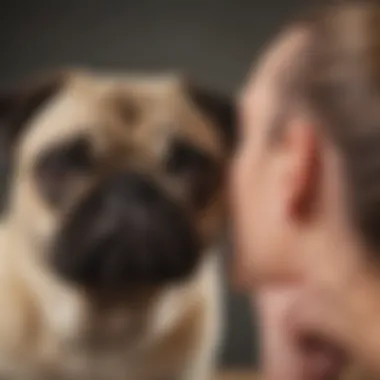Effective Treatments for Pug Ear Infections


Intro
Pugs are beloved companions, but their unique ear structure makes them more susceptible to ear infections. Understanding how to treat and prevent these infections is essential for any pug owner. This guide aims to present a comprehensive look at pug ear infection treatment while providing valuable insights into their overall care.
Understanding Your Pet
Breed Traits
Pugs possess a distinct physical conformation that affects their ear health. Their small ears can trap moisture and debris, promoting an environment where bacteria and yeast thrive. Regular checks are important to catch any early signs of infection.
Common Temperaments
Pugs are generally friendly and lively. They often show affection towards their owners. However, some pugs can become irritable when feeling unwell, particularly if they have an ear infection. Recognizing changes in behavior can be crucial for early detection.
Special Needs
Due to their unique features, pugs may require more frequent ear cleaning than other breeds. Proper maintenance is necessary to keep their ears dry and free from buildup.
Pet Care Essentials
Nutrition and Feeding Guidelines
A balanced diet is vital for maintaining a pug's immune system. High-quality dog food tailored to their specific needs plays a role in overall health. Avoiding overfeeding is crucial, as obesity can lead to various health issues, including ear infections.
Grooming Tips and Techniques
Regular grooming significantly minimizes ear infection risk. It is advisable to clean their ears weekly, using vet-approved solutions. Additionally, maintaining a weekly grooming routine can help catch any ear-related problems early.
Health and Wellness
Regular vet check-ups promote early detection of any potential health concerns. Vaccinations and preventive care are essential for ensuring your pug remains healthy.
Treatment Options
Home Remedies
Some owners turn to home remedies for minor ear issues. Gentle cleaning with a mix of water and vinegar may help alleviate discomfort. Always consult with a veterinarian before trying any remedy to ensure safety.
Veterinary Intervention
In more severe cases, seeking a veterinarian's advice is critical. They may prescribe medicated ear drops or oral antibiotics depending on the infection's severity. Don't hesitate to reach out if you notice persistent symptoms.
Preventive Measures
Regular prevention strategies can save your pug from the trouble of ear infections. Ensure their ears are thoroughly dried after baths or swimming. Keeping their living environment clean reduces the chance of infections caused by environmental factors.
Post-Treatment Care
Following any treatment regimen, continue monitoring your pug closely. Follow-up visits with the vet may be necessary to confirm the infection has resolved completely. Always maintain proper cleaning habits, ensuring you monitor their behavior and ear condition moving forward.
"Preventive care is key to maintaining your pug's ear health and overall well-being."
Epilogue
Understanding pug ear infection treatment involves knowing their unique anatomy and addressing their specific needs. By incorporating regular care routines, monitoring symptoms, and seeking proper treatment, pug owners can effectively manage their pets' ear health.
Understanding the Pug's Ear Anatomy
Understanding the pug's ear anatomy is crucial for every pug owner. The ear structure significantly influences the risk of ear infections and other conditions. Knowledge of how a pug's ear functions allows for better preventive care and quicker identification of potential problems. Moreover, recognizing anatomical features will enable owners to provide more effective treatments when issues arise.


External Ear Structure
The external ear of a pug consists mainly of two parts: the pinna and the ear canal. The pinna is the visible part of the ear, which is floppy in pugs. This unique shape can trap moisture and moisture, making them more susceptible to infections. The ear canal runs from the pinna to the eardrum. It is relatively short but bends sharply. This structure can create a perfect environment for bacteria and fungi to thrive. Regular inspection and cleaning of the external ear can help in early detection of issues.
Internal Ear Components
The internal ear includes the middle and inner ear, which are not visible from the outside. The middle ear contains the eardrum and three tiny bones that contribute to hearing. It is responsible for sound transmission. The inner ear has vital components for both hearing and balance. While issues in these areas are less common, they can be severe and require immediate veterinary attention. Understanding these components emphasizes the importance of observing any unusual behavior in your pug, as it may indicate underlying issues.
Common Causes of Ear Infections in Pugs
Understanding the common causes of ear infections in pugs is crucial for any pet owner. Ear infections can lead to discomfort and serious health issues if not addressed promptly. By identifying the root causes, pug owners can take preventative measures and respond swiftly to symptoms. This section explores the four main causes of ear infections in pugs, ensuring you are well-informed.
Allergies and Sensitivities
Pugs are often sensitive to various environmental factors, including pollen, dust, and certain foods. Allergies can trigger inflammation in the ear canal, increasing the risk of infection. It’s important for owners to recognize early signs of allergies in their pugs, such as itching or frequent ear scratching. Tracking your pug’s exposure to allergens can aid in identifying triggers. Using hypoallergenic foods and maintaining a clean living environment are helpful strategies.
Bacterial and Fungal Infections
Bacterial and fungal organisms are common culprits behind ear infections in pugs. These infections typically develop when the ear's natural defenses are compromised. Pugs may experience moisture retention in their ears, creating an ideal environment for these pathogens to multiply. Owners should monitor their pets for signs of infection, including odor, discharge, or redness in the ear canal. Consulting with a veterinarian for appropriate medications is critical if an infection occurs.
Ear Wax Build-Up
Excessive ear wax can clog the ear canal, leading to discomfort and potential infections. Pugs, with their unique ear structure, are particularly prone to this issue. Regularly cleaning your pug’s ears can help prevent wax accumulation. Use veterinarian-recommended ear cleaning solutions and avoid using cotton swabs, as these can push wax deeper into the ear.
Foreign Objects in the Ear
Sometimes, pugs may get foreign objects lodged in their ears, such as grass, dirt, or small debris from outdoor play. These objects can cause irritation, infection, and sometimes severe pain. Observing your pug’s behavior and checking their ears regularly can help catch such issues early. If you suspect your dog has something stuck in their ear, seeking veterinary assistance is advisable rather than attempting to remove it yourself.
Identifying Symptoms of Ear Infections
Identifying symptoms of ear infections is a crucial aspect of maintaining a pug’s overall health. Pugs often suffer from ear issues due to their unique anatomy, which can trap moisture and debris. Early detection of symptoms can lead to effective treatment, preventing complications that may arise from untreated infections. Recognizing the signs not only helps in providing immediate care but also in seeking veterinary assistance when necessary. This section will outline the physical signs and behavioral changes that indicate a pug may be suffering from an ear infection.
Physical Signs to Look For
When examining a pug for ear infections, several physical signs can be indicative of trouble. Here are some key symptoms to monitor:
- Redness and Swelling: The inside of the ear may appear reddened or swollen, suggesting inflammation.
- Discharge: Look for any unusual discharge, which may be thick and have a foul odor. This often indicates an infection present.
- Excessive Wax: A notable increase in ear wax can be a sign that the ears are not healthy.
- Heat: The ear may feel warmer to the touch compared to other areas of the body.
- Scratching or Rubbing: Frequent scratching at the ear or rubbing the ear against furniture may indicate discomfort.
If these physical signs are observed, it is essential to monitor the pug closely. These symptoms can progress quickly, requiring prompt intervention to alleviate discomfort and prevent further complications.
Behavioral Changes
Beyond physical signs, changes in behavior can also suggest that a pug is experiencing ear problems. Notable behavioral changes include:
- Increased Irritability: A normally sociable pug may display signs of irritability or withdrawal.
- Altered Activity Levels: A pug may become less active or more lethargic if it is in pain.
- Discomfort During Touch: Affected dogs often react negatively when their ears are touched, indicating sensitivity.
- Head Tilting: A pug might tilt its head to one side, possibly trying to alleviate discomfort or due to balance issues caused by an infection.
- Change in Routine: Alterations in eating or sleeping habits can signal underlying health issues.
Recognizing these behavioral changes is essential for timely intervention. Pugs communicate their discomfort in various ways; being attentive can lead to early detection and treatment of ear infections.
Identifying symptoms early on can enhance the quality of life for your pug. Immediate steps taken can lead to more effective treatment options. When observing these signs, it is advisable to compile this information before consulting with a veterinarian to facilitate a comprehensive examination.
Consulting a Veterinarian
Consulting a veterinarian is a critical step in ensuring the health of your pug’s ears. While some ear infections may seem manageable at home, a professional diagnosis is essential. Pugs, like many breeds, have unique ear structures and varying health concerns. Those factors can complicate what might appear as a simple issue.
Veterinarians not only provide treatment but also identify underlying causes. These may include allergies, infections, or structural issues within the ear. Understanding these aspects will help prevent recurring problems. Moreover, professional veterinary care ensures the animal receives appropriate medications, as improper treatment can lead to more severe complications.
When you take your pug to the vet, experts assess the condition using specialized tools and tests. They will evaluate your dog’s medical history and conduct a thorough physical examination of the ear. Ideally, addressing ear infections promptly can prevent further discomfort for your pet and promote quicker recovery.
Early intervention is often key to a successful treatment regimen.


When to Seek Professional Help
Knowing when to consult a veterinarian is crucial. If you notice any of the following signs, it may be time to make an appointment:
- Persistent scratching of the ears
- Unusual odor coming from the ear canal
- Redness or swelling in the ear area
- Discharge or fluid leaking from the ears
- Changes in behavior, such as increased irritability or lethargy
These symptoms can indicate more serious conditions that require veterinary intervention. Waiting too long can worsen the situation, making treatment more complex and painful for the dog.
What to Expect During the Examination
During a veterinary examination, the process is usually systematic and thorough. As a pet owner, it helps to know what to expect:
- Initial Assessment: The veterinarian will ask about your pug’s symptoms, any medications, and environmental factors.
- Ear Inspection: Using an otoscope, the vet examines the ear canal for signs of infection, inflammation, or foreign objects.
- Lab Tests: Samples may be collected to identify the type of infection—bacterial, fungal, or parasitic.
- Discussion of Findings: After the examination, the veterinarian will explain the diagnosis and recommend treatments.
- Follow-Up Care: Plans for follow-up consultations may be established to monitor progress and adapt treatment as needed.
Understanding these steps can prepare you for the visit and help ease any anxiety about the examination process. Ultimately, veterinary care plays an essential role in maintaining your pug’s ear health and overall well-being.
Treatment Options for Ear Infections
Treating ear infections in pugs requires a balanced approach between professional veterinary care and at-home management. Understanding the treatment options is crucial for pet owners, as it enables them to make informed decisions that promote the health of their beloved companions. This section elaborates on various treatments available, emphasizing the significant role they play in restoring a pug's ear health.
An ear infection can lead to discomfort and pain for pugs, who cannot verbally express their distress. Therefore, timely treatment is essential to prevent complications. The treatment options discussed here focus on medications prescribed by veterinarians and home remedies that can effectively complement professional care. Knowing how these treatments work can also help owners monitor their pet's recovery efficiently.
Medications Prescribed by Veterinarians
When a pug is diagnosed with an ear infection, a veterinarian often prescribes specific medications tailored to the type and severity of the infection. These medications may include:
- Antibiotics: For bacterial infections, antibiotics help eliminate harmful bacteria from the ears. It is vital to complete the full course as directed by the vet, even if symptoms improve before the medication finishes.
- Antifungal Medications: In cases of fungal infections, antifungal treatments are necessary to eradicate the infection. Similar to antibiotics, these should be administered as prescribed.
- Anti-Inflammatory Drugs: These can alleviate pain and swelling in the ears, making the pug more comfortable during recovery. Non-steroidal anti-inflammatory drugs (NSAIDs) are commonly used for this purpose.
- Ear Drops: Specific ear drops that combine antiseptics and other active ingredients can be effective in tackling infections. These drops may also help to flush out debris or wax build-up,
It is important to follow the veterinarian's guidance on how to apply medications properly. Owners should also be aware of possible side effects and report any unusual reactions to the veterinarian.
Home Remedies to Consider
Some pet owners look for ways to manage ear infections at home. While not a replacement for veterinary care, certain remedies can help soothe symptoms. Some home remedies that may be useful include:
- Cleanse with a Mild Solution: Diluted apple cider vinegar or a gentle saline can clean the outer ear. This does not replace veterinary treatment but may help alleviate discomfort.
- Warm Compress: Applying a warm, damp washcloth on the ear can provide comfort. This can help soothe inflammation and make the pug calmer.
- Prevent Moisture: Keeping the pug's ears dry is crucial. After baths or swimming, gently dry the ears with a soft towel.
- Dietary Adjustments: A balanced diet can also impact ear health. Some owners consider adding omega-3 fatty acids to their pug's diet, which may have anti-inflammatory properties.
In summary, treatment options for ear infections encompass both veterinary-prescribed medications and home remedies. Both play a role in managing the condition, promoting healing and comfort for the pug. Pet owners should stay informed about these options to enhance their pet’s ear health effectively.
Preventive Measures for Ear Health
Preventive measures are crucial in ensuring optimal ear health for pugs. Given the breed’s unique ear structure, they are particularly susceptible to infections and other ear problems. Taking proactive steps can lead to reduced incidences of ear infections, ensuring that pugs maintain comfort and a better quality of life. In this section, we will discuss specific techniques for regular cleaning and dietary considerations that can significantly contribute to healthy ears.
Regular Cleaning Techniques
Regular cleaning of a pug’s ears is vital for preventing the buildup of wax and debris, which can encourage infection. Most owners should establish a routine ear cleaning schedule. Here are some effective techniques for ear care:
- Choose the Right Cleanser: Select a vet-recommended ear cleaner that is pH balanced for dogs. Avoid alcohol-based products as they can irritate the ear.
- Gentle Application: Use a cotton ball or soft cloth to apply the cleanser. Avoid using cotton swabs as they can push debris further down the canal and cause injury.
- Frequency: Clean the ears once every one to two weeks or as advised by your veterinarian. Monitor their ears for any signs of infection before intervals.
Regular inspections during cleaning can help identify early signs of issues. If you notice unusual smells, discharge, or redness, consult your vet promptly.
Dietary Considerations
Nutrition plays a significant role in overall health, including ear health. Poor diet can lead to allergies, which are a common cause of ear infections. Here are some dietary measures to consider:
- High-Quality Dog Food: Ensure your pug is on a high-quality diet that provides essential nutrients. Ingredients like omega-3 fatty acids can help promote skin and coat health, potentially reducing affected skin around the ears.
- Identify Allergens: Be cautious of food allergies. Consult your veterinarian about allergy testing or a special elimination diet if you suspect food sensitivity.
- Hydration: Provide fresh water at all times. Adequate hydration helps maintain skin moisture and can indirectly benefit ear health.
Good nutrition does not only support overall health, but it also plays a critical role in ear health for pugs. Taking care in this area can lead to fewer vet visits down the line.
Post-Treatment Care for Pugs


Post-treatment care is crucial for ensuring a complete recovery from ear infections in pugs. After a pug undergoes treatment, whether it be medication or home remedies, it is important to monitor their condition closely. Effective care during this period can significantly impact the longevity of their ear health and prevent potential complications.
Monitoring Recovery
Monitoring recovery involves observing your pug’s behavior and physical condition after treatment. Look for any signs of discomfort or changes in behavior that might indicate a recurring problem. Watch for the following:
- Ear Scratching: Frequent scratching could suggest lingering irritation.
- Discharge: Any new or persistent discharge from the ear canal should be noted.
- Unusual Odors: Foul smells can indicate infection or other issues.
By keeping a close eye on these symptoms, you can make informed decisions about the need for further intervention. Regular checks can foster a quick response to any signs of relapse.
Follow-Up Vet Visits
Follow-up vet visits are essential in ensuring that your pug is on the right path to recovery. These appointments provide an opportunity for the veterinarian to assess the effectiveness of the initial treatment. Here are some key points regarding follow-up visits:
- Assessment of Healing: The vet will examine the ears to determine if healing is progressing.
- Adjustments to Treatment: If necessary, they may prescribe additional medications or recommend a different treatment plan.
- Education: Your vet can offer insights on how to manage ear care going forward.
Ideally, these visits should take place as recommended by your veterinarian, typically a week or two after the initial treatment. Keeping a regular schedule with vet visits helps to affirm a proactive approach to your pug's long-term ear health.
Regular follow-up is essential to ensure healing and assess the effectiveness of the treatment plan.
In summary, both monitoring recovery and follow-up vet visits form the foundation of effective post-treatment care. This multifaceted approach ensures that the pug not only recovers fully but also enjoys sustained ear health over time.
Long-Term Considerations for Pug Ear Health
Maintaining the ear health of a pug requires a long-term commitment. This commitment ensures that the dog's ears remain free from infections and other complications. Pugs, with their unique ear structure, are more susceptible to various ear ailments. Hence, understanding long-term care and preventive measures is crucial for any pug owner.
Consistent observation is one key element in preventing recurring problems. Owners should routinely check their pug's ears for signs of discharge, odor, or redness. These early signs can indicate an underlying issue that, if addressed promptly, may prevent a more serious infection. Education about the ear's anatomy and common conditions can empower owners to take proper action when needed.
Regular cleaning also plays a significant role. It is essential to use safe and vet-recommended cleaning solutions. Gently wiping the outer ear with a soft cloth can greatly reduce wax buildup and help avoid potential blockages. Proper techniques are necessary to avoid damaging the ear canal or causing irritation.
Another important consideration is the pug’s environment. Ensuring a clean living space can reduce allergens and irritants that may lead to ear infections. Introducing dietary changes may also prove beneficial. Certain allergies can stem from food, making it important to monitor a pug's diet and consult with a veterinarian about any changes.
"An ounce of prevention is worth a pound of cure." In the case of ear health, this statement holds particularly true for pugs.
In summary, the long-term considerations for a pug's ear health involve consistent observation, proper cleaning, and attention to environmental factors. Owners should remain proactive in their approach to overall ear care, ensuring their pets enjoy better health and fewer visits to the vet.
Recognizing Recurring Issues
Recurring ear infections in pugs can signal a more significant problem. Owners need to be vigilant and recognize patterns in their pet's ear conditions. Frequent infections may indicate issues such as allergies, insufficient cleaning, or environmental factors. Keeping a journal or a log of each incident can aid in identifying triggers and help in effective management.
Allergies, in particular, are often culprits behind recurrent ear infections. Assessing food ingredients or environmental allergens can facilitate solutions. Regular discussions with your veterinarian can also provide insights on managing any ongoing issues.
Annual Health Checks
Annual health checks are vital for maintaining ear health in pugs. These checks provide an opportunity for veterinarians to examine the ears thoroughly. They can detect early signs of problems that may not be apparent to owners.
During these visits, additional tests may be performed, such as allergy testing or ear culture tests. These can help diagnose underlying causes of repeated infections. Following the veterinarian's recommendations after these check-ups can lead to a better understanding of a pug’s specific ear health needs.
In essence, combining vigilant observation with annual veterinary health checks creates a robust plan for maintaining your pug’s ear health. Owners should feel empowered to take an active role in their pet’s ear care and overall well-being.
Culmination
Understanding the anatomy of a pug's ear is important as it helps owners recognize the intricacies that can lead to infections. By grasping the common causes, such as allergies and bacteria, pug owners can take proactive steps to minimize risks.
The section on identifying symptoms provides valuable insights into both physical signs and behavioral changes, ensuring that pet owners can spot issues early. Early detection often leads to better outcomes.
When it comes to treatment, knowing the options available, whether through professional veterinary assistance or home remedies, empowers owners to make informed decisions. It's essential not just to treat but to follow through with post-treatment care to ensure full recovery.
Long-term considerations play a significant role in sustaining ear health. Recognizing recurring issues and committing to annual health checks can prevent future problems. By synthesizing the information outlined in this article, pug owners can better manage their pet’s ear health effectively.
Ultimately, being vigilant and educated about ear care significantly benefits the overall quality of life for pugs. Prevention is always better than cure, and a proactive approach to ear health ensures that pugs can live comfortably and happily.
Summary of Key Points
- Ear anatomy:Understanding structure aids in recognizing problems.
- Causes of infections: Allergies, bacteria, and environment must be monitored.
- Symptoms: Observing behaviors can lead to early detection.
- Treatments: Options range from veterinary care to home remedies.
- Prevention: Regular cleaning and diet contribute to ongoing ear health.
- Follow-up care: Regular check-ups and monitoring recovery are crucial.
- Long-term vigilance: Stay alert for signs of recurrence to address issues promptly.



